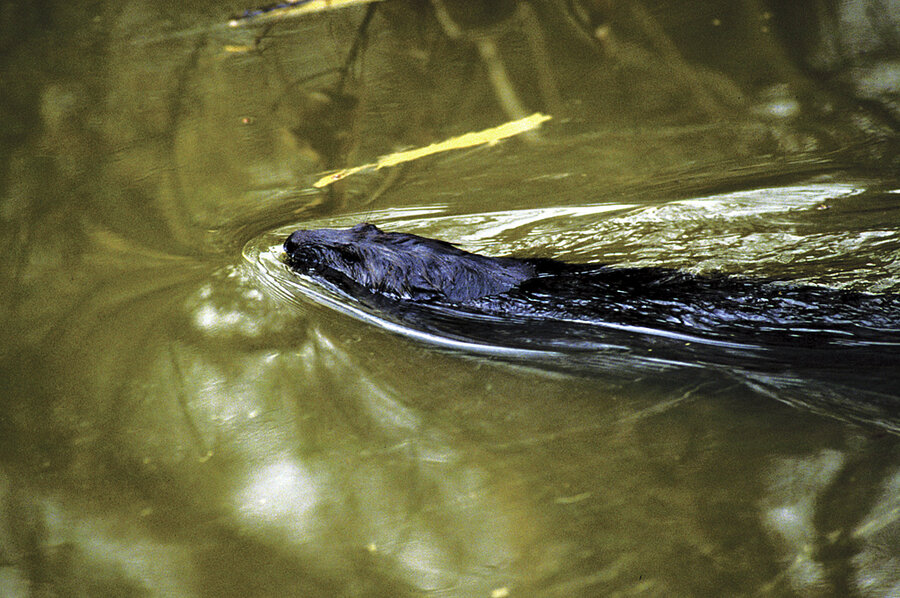Disappearing trees and the slap of a tail: The beavers had arrived
Loading...
Unbidden and unnoticed, they crept into our corner of rural New England early last fall. Initially, we paid no mind to the branches in the middle of our wide, full brook – assuming they'd fallen and collected there arbitrarily. Then my husband paused one evening at the bridge overlooking the waterway. Slap! went the tail of a startled creature.
Beavers resided on our brook.
They began stanching the stream in earnest. Twig by twig, branch by branch they slowed, then virtually stopped, the fast-flowing water. By mid-autumn, they'd built a significant structure, creating behind it a deep, clear pool that caused water to overflow the banks of the brook and into neighbors' fields. Upon breaching the barrier, our neighbor found a canoe oar among the debris and gladly took it home.
Undaunted, the beavers built back the dam, higher and sturdier. Equally undaunted, I made my assault on the edifice.
I began at one edge of it, pulling off branches so recently severed that the leaves on them were crisp and green. These were fortified with hordes of colorful leaves, which had fallen from the nearby oaks and maples and congregated in the newly formed pool. Rocks – some quite large – were fitted generously into the whole, providing, along with several beer cans and dozens of crab apples, a substantial foundation. Black muck, dredged from the banks and bottom of the brook, cemented all the components together.
I felt evil about destroying the beavers' efforts but also exhilarated to see amber-colored liquid cascading through openings I'd created in the construction.
I worked until my muscles ached and the insides of my green wellies – to say nothing of jeans, turtleneck, and flannel shirt – became soaked. My afternoon's work accomplished, the brook ran freely again – but for no more than a week or two, until, predictably, the beavers began to rebuild.
Meanwhile, the bordering woods were being culled of small to medium-sized trees. This included one larger specimen that was gnawed through and felled onto a power line at 5:45 one morning – just when some neighbors were getting ready for work.
This was a major inconvenience; the water in the wells we use is accessed via electric pumps. One woman was showering – soaped from head to toe – when her water supply shut off.
The beavers had become a problem.
Our town's road maintenance crew came with a front-loader and dismantled the dam, expecting it be rebuilt then destroyed again until, frustrated, the critters moved to another location. They relocated immediately – but only yards away to an old millpond adjacent to the brook.
Day by day, trees were downed and became half-submerged in the pond. The spillway to the brook became blocked; a mound of twigs formed, marking the animals' domicile. The size of the millpond quadrupled then grew until, by wintertime, it was six times its original size. Bark was gnawed off the fallen trees until they looked like specters floating in the water. The beaver lodge resembled a pile of bleached bones.
At dusk, I'd notice ripples on the pond. Sometimes, I'd see a furry head and back cruising through the water. Curiously, I never saw more than one, making me wonder if family members took turns venturing out.
Come springtime, the creatures caught the attention of state authorities. On consecutive weekends, teams showed up, taking photos of the area as well as wading into the murky depths to set traps.
By early summer, the millpond was covered with algae: a solid, chartreuse mass unbroken by a single ripple of movement. The brook ran unobstructed; saplings and brush re-grew in the nearby woods. I stared wistfully at the mound that had once housed such industrious – if destructive – interlopers, as their dwelling increasingly became obscured by the steady creep of lush, green foliage. It was quiet on the waterways. Too quiet.
Midsummer hit with suffocating heat and humidity; there was only one sure way to cool off. The millpond was unappealing, but the brook ran clear and was chilly enough to make a strong man shout.
The water level was low in our section, so I slogged upstream, looking for a suitable place for a dip. I came to a pool – deep and wide – formed behind a substantial collection of branches. The structure spanned the waterway and slowed the flow. And was that a mound of twigs off to one side?
I exited the area – not waiting for the warning slap of a tail.





